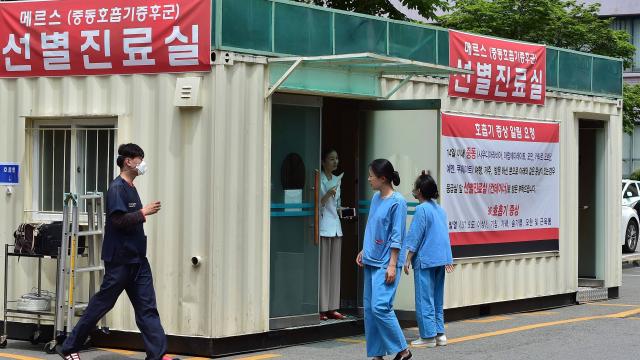- California Assembly OKs highest minimum wage in nation
- S. Korea unveils first graphic cigarette warnings
- US joins with South Korea, Japan in bid to deter North Korea
- LPGA golfer Chun In-gee finally back in action
- S. Korea won’t be top seed in final World Cup qualification round
- US men’s soccer misses 2nd straight Olympics
- US back on track in qualifying with 4-0 win over Guatemala
- High-intensity workout injuries spawn cottage industry
- CDC expands range of Zika mosquitoes into parts of Northeast
- Who knew? ‘The Walking Dead’ is helping families connect
After MERS outbreak, S. Korea to improve monitoring, quarantine protocol

The South Korean government hopes to better contain viral outbreaks after the difficulties it had with the recent MERS outbreak. (Yonhap)
SEOUL/SEJONG (Yonhap) — South Korea will set up a dedicated monitoring and response system and greatly increase quarantine infrastructure to effectively cope with future contagious outbreaks, the government said Tuesday.
The plan reached at the national policy coordination meeting chaired by Prime Minister Hwang Kyo-ahn calls for an overhaul of the country’s ability to respond to medical emergencies that was proven woefully inadequate in containing the recent Middle East Respiratory Syndrome (MERS) outbreak.
After the first confirmed case on May 20, the respiratory illness spread quickly, mostly through hospitals, resulting in the deaths of 36 people. A total of 186 people were infected by the MERS-inducing virus, with the last case being reported on July 4.
“The lack of knowledge, medical experts and training prevented health authorities from containing MERS in the early stages,” said Health Minister Chung Chin-youb. He said the government will look into all shortcomings detected and make necessary changes.
As part of the changes, the country will set up a 24-hour Emergency Operations Center (EOC) that will keep track of all suspected contagious disease cases and be ready to dispatch quarantine officials, and civilian medical experts to the site of a possible outbreak. The government will also have a specialized risk communication office to facilitate the flow of timely and accurate information to the public and between medical institutions, and work with international health agencies to keep abreast of all contagious disease outbreaks abroad.
Seoul, moreover, will appoint a vice minister official to head the Korea Centers for Disease Control and Prevention (KCDC) that can give the agency greater ability to coordinate in emergency situations. At present the public safety and health agency chief is a deputy ministerial position.
The government then said that measures will be taken to revamp the four-tiered alert system so the prime minister and related ministries can get involved early on in case of an outbreak. It added that funds will be made available to have enough negative pressure isolation rooms to treat 1,500 patients at once by 2025. All general hospital with more than 300 beds will be required to have negative pressure rooms that are effective in controlling respiratory-related contagious diseases.
Besides such measures, the government will reform the way general hospitals operate overcrowded emergency rooms and better regulate visiting hours for patients.
People showing symptoms of contagious disease will be kept in separate quarantine rooms, with efforts being made to prevent non-critical patients from using emergency rooms.
The country’s hospitals took flak for playing a part in the transmitting of MERS. The Korean tradition of visiting friends and relatives at hospitals came under scrutiny as well, since these people became infected and helped spread MERS.
The government, meanwhile, said it will expand research and development on contagious diseases, maintain a comprehensive database on illnesses. It said measures will be taken to increase expert medical personnel like epidemiologists that can permit the country to deal with emergencies.















